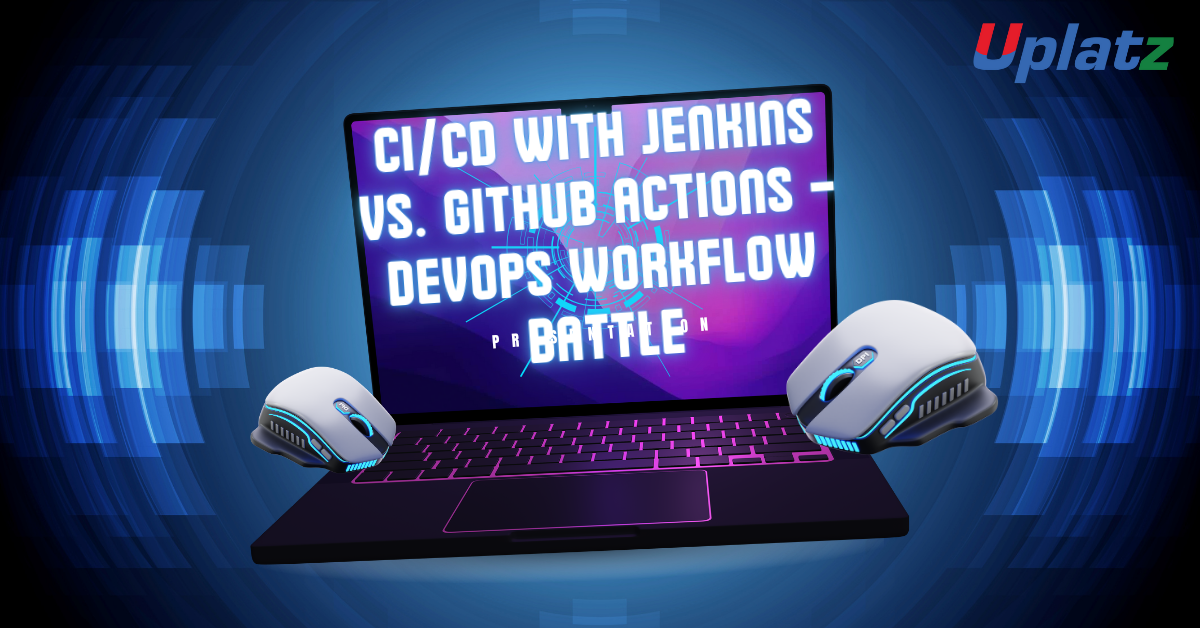CI/CD with Jenkins vs. GitHub Actions – DevOps Workflow Battle
Continuous Integration and Continuous Delivery (CI/CD) are cornerstones of modern DevOps workflows, automating code building, testing, and deployment. Jenkins and GitHub Actions are two leading platforms in this space, each with distinct architectures, feature sets, and cost models. This report compares Jenkins and GitHub Actions across key dimensions to help teams select the tool best aligned with their needs.

- Overview
Jenkins is a mature, open-source automation server written in Java, supported by CloudBees, with over 1,500 plugins for extensibility and a traditional master-agent architecture that distributes tasks across nodes.
GitHub Actions is a native GitHub workflow automation platform introduced in 2019, enabling event-driven CI/CD directly within repositories via YAML-defined workflows, with both GitHub-hosted and self-hosted runners.
- Architecture and Workflow Definition
Jenkins
- Master-Agent Model: A central master coordinates jobs; agents execute builds on various platforms.
- Pipeline as Code: Uses Jenkinsfile in Groovy or DSL to define pipelines version-controlled alongside code.
- Plugin Ecosystem: Extensible via plugins for SCM, build tools, test frameworks, and notifications.
GitHub Actions
- Event-Driven Workflows: Workflows trigger on repository events (push, pull request, schedule) defined in .github/workflows/*.yml file.
- Jobs and Steps: Jobs bundle steps (shell commands or actions); matrix builds enable parallel testing across environments.
- Marketplace Actions: Over 16,000 reusable actions available, with verified publishers for common tasks.
- Extensibility and Integrations
| Feature | Jenkins | GitHub Actions |
| Plugin/Action Count | ~1,500 plugins covering broad DevOps tools | ~16,730 Actions in Marketplace, rapidly growing |
| Self-Hosted Runners/Agents | Agents on any OS; master schedules jobs accordingly | Custom self-hosted runners shareable across orgs |
| Third-Party Integrations | Integrates with Git, Docker, Maven, Kubernetes, etc. | Native GitHub API, deep GitHub ecosystem integration |
| Configuration GUI | Web UI plus direct config.xml editing | YAML in code; no separate GUI beyond GitHub interface |
- Scalability and Performance
- Jenkins auto-scales via agent provisioning but requires infrastructure management; ideal for large, complex, long-running pipelines.
- GitHub Actions scales on GitHub-hosted runners with generous free minutes for public repos; large enterprise usage possible with self-hosted runners and GitHub Enterprise plans.
- Pricing Model
Jenkins
- Open Source: Free; users manage their own servers and infrastructure costs.
- CloudBees Jenkins: Commercial support and SaaS options add subscription fees.
GitHub Actions
- Public Repositories: Unlimited free minutes on GitHub-hosted runners.
- Private Repositories: Plans include free minutes/storage; overages billed per runner type: Linux $0.008/min, Windows $0.016/min, macOS $0.08/min.
- Self-Hosted Runners: No usage fees, only infrastructure costs.
- Market Adoption and Usage
Jenkins remains widely adopted with an estimated 44% CI/CD market share and 73 million monthly jobs in mid-2023, reflecting its enterprise penetration. GitHub Actions has seen explosive growth, crossing 1 billion minutes of usage in a single month by early 2023 and adoption by nearly 30% of top open-source repos.
- Advantages and Limitations
Jenkins Advantages
- Mature and Stable: Battle-tested since 2004 with a robust community.
- Deep Extensibility: Extensive plugin ecosystem for complex integrations.
- Pipeline Customization: Full control over pipeline logic via code.
Jenkins Limitations
- Infrastructure Management: Requires provisioning and maintenance of masters/agents.
- UI Complexity: Older interface can be cumbersome; pipelines often require manual tuning.
- Steep Learning Curve: Groovy-based pipelines and XML configs demand expertise.
GitHub Actions Advantages
- Native GitHub Integration: Seamless with repos, pull requests, issues, and CI/CD in one place.
- Ease of Use: YAML syntax and Marketplace actions simplify pipeline creation.
- Event-Driven: Flexible triggers for various GitHub events; matrix builds out-of-the-box.
GitHub Actions Limitations
- Usage Costs for Private Repos: Minute-based billing can be unpredictable for heavy workloads.
- Feature Maturity: Enterprise features (e.g., audit logs) evolving but may lag specialized CI servers.
- Customization Constraints: Complex pipelines may require workarounds compared to Jenkins’ full scripting.
- Recommended Use Cases
- Choose Jenkins when requiring highly customized, large-scale pipelines, plugin-driven integrations across diverse tools, and full control over CI/CD infrastructure within on-prem or hybrid environments.
- Choose GitHub Actions for repositories hosted on GitHub, teams seeking integrated CI/CD with minimal setup, open-source projects benefiting from free runners, and event-driven workflows closely tied to GitHub events.
Conclusion: Both Jenkins and GitHub Actions offer powerful CI/CD capabilities. The decision hinges on existing infrastructure, required extensibility, cost considerations, and team expertise. Jenkins excels in highly customized, self-managed environments, whereas GitHub Actions provides streamlined, integrated workflows for GitHub-centric projects.
